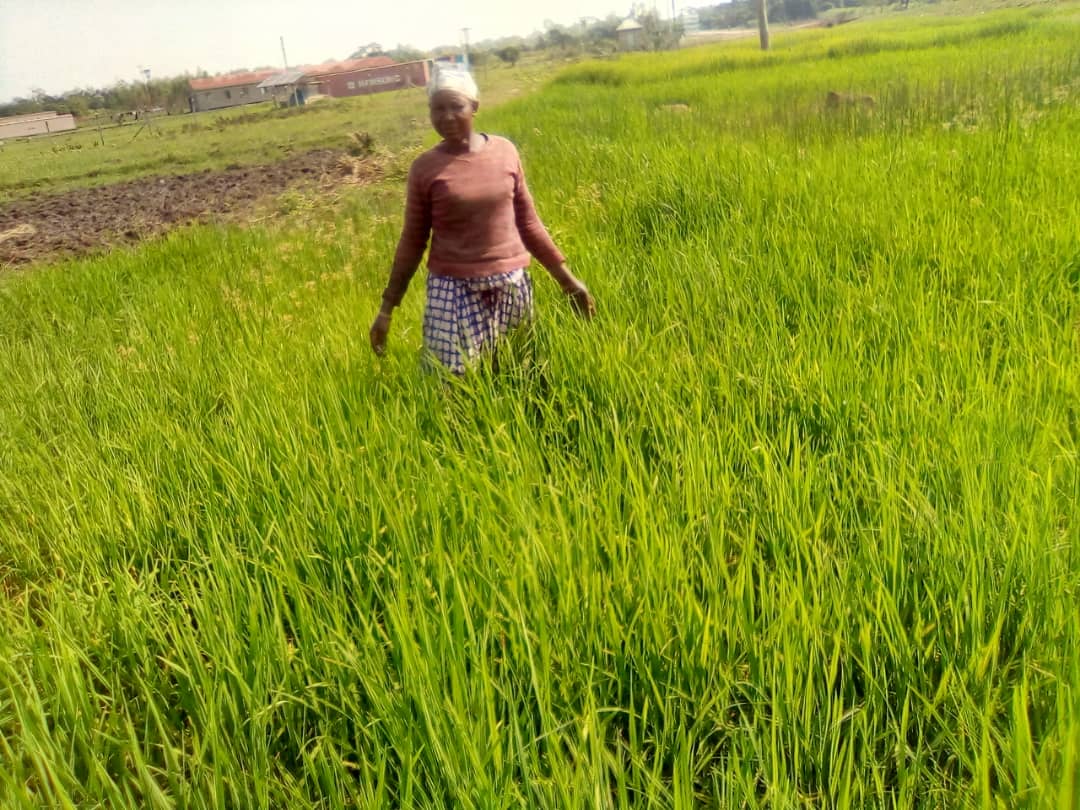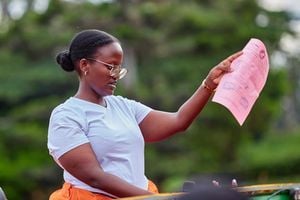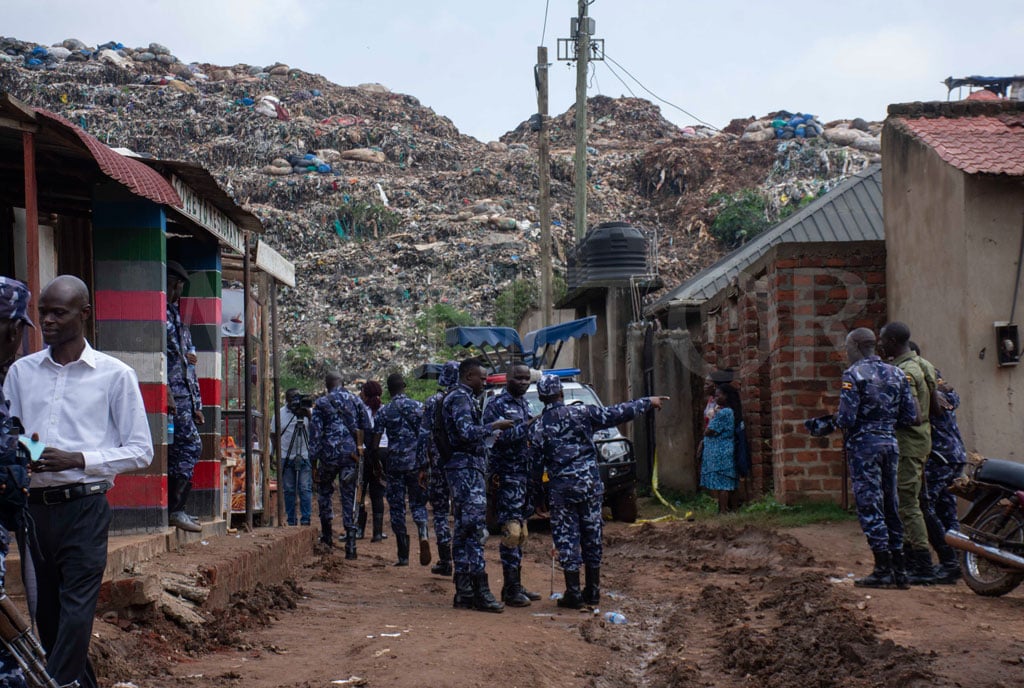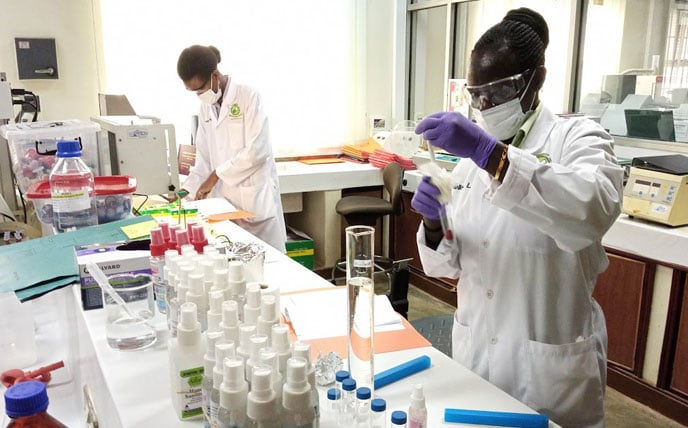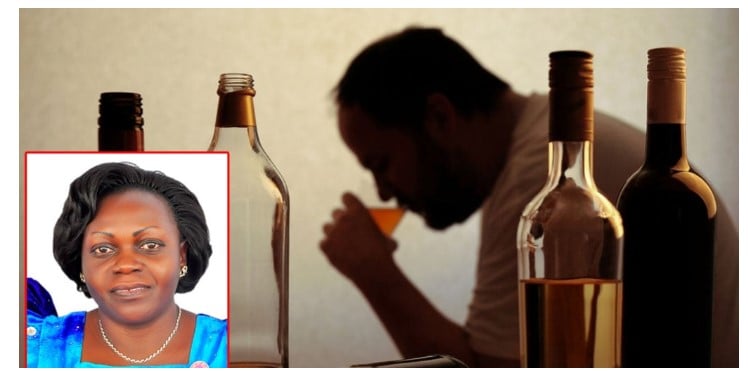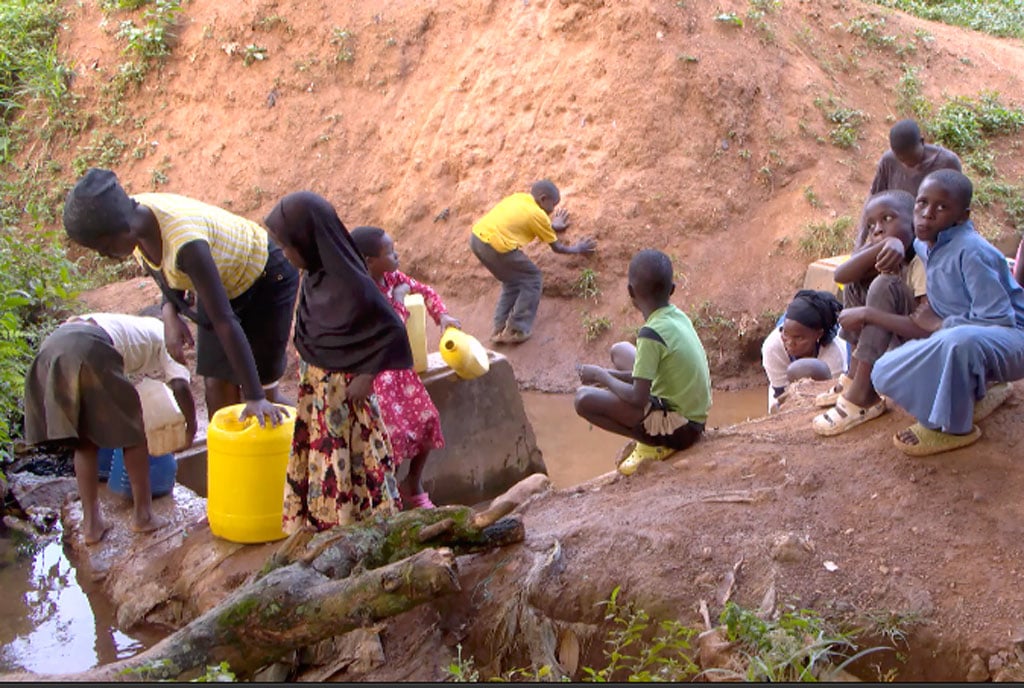
Children playing at the water spring is Mawero East B Village, Busia District in 2024. PHOTO/GILLIAN NANTUME
At 6pm, you would expect school going children to be at home, relaxing, after a long day partaking in the exchange of knowledge. Perhaps, they would be doing homework.
But in Mawero East B village, Eastern Division, in Busia town, children are playing at the constructed water spring. Small five litre jerry cans of different colours stand discarded near the spring as the children shout to each other, laughing at their jokes.
The spring has three pipes from which groundwater should be flowing. Only one pipe is working, though, and the water comes out in a trickle. To reach the pipe, one has to wade through a stagnant paddle of brown water, as Hafsa Turuteya and her daughter are doing. The stagnant water is almost at the same level as the water pipe.
They are both carrying 20 litre yellow jerry cans. “The biggest challenge is the amount of time one spends at the spring. You can come here at 2pm and leave at 6pm because of the long lines. The stagnant water is not safe, either. There are insects that live in there and they bite us as we wait for our jerry cans to fill up,” she says as she bends down to put the mouth of the jerry can near the pump
The water spring serves over 500 people from the villages of Mawero East B, Kinyole and Kayoola. Turuteya, a charcoal seller, adds that the time she spends fetching water has an impact on her income.
According to the World Health Organisation (WHO), 1.8 billion people live in households without water supplies on the premises. Water insecurity affects the lives of women and girls because they are responsible for fetching water in seven out of ten households without supplies on the premises.
The cost of water insecurity
According to a UNICEF and WHO report, Progress on household drinking water, sanitation and hygiene (WASH) 2000-2022: Special focus on gender, girls under 15 years are more likely than boys under 15 to fetch water. In most cases, women and girls make longer journeys to collect it, losing time in education, work, and leisure, and putting themselves at risk of physical injury and dangers on the way.
Turuteya, a mother of six is a charcoal seller. She says amount of time she spends at the borehole have an impact on her income.
“If I spend four hours here, I lose many customers – those who would have bought a sack of charcoal and those who buy on a small scale. However, we need the water and my family uses six jerry cans of a day. Besides, the water here is free of charge. The other alternative is to pay money and collect the water from a tap,” she says.

Hasfa Turuteya fetches water at a spring in Busia District. PHOTO/GILLIAN NANTUME
The water spring is located in a valley surrounded by shrub and trees. The houses near the spring do not have security lights outside, which means the area around the spring can be pitch black at night. In the darkness women and girls are vulnerable to abuse.
“If you come with two jerry cans, you cannot fill them in succession. You must fill one and allow other people to take their turn as well. This means leaving the spring late in the night. Sometimes, my daughters return home at midnight. I know it is not safe for them, because young men smoke marijuana in the bushes surrounding the spring. But I advise them to walk in groups with other people,” Turuteya says.
Busia town is one of the important border gateways into the country. The district local government plants to request the government to elevate the town to city status. However, water and sanitation are tied that elevation as the town is dogged with insufficient water supply with 1,046 inactive connections, dilapidated public toilets and insufficient sanitation facilities in public places and institutions.
Current water coverage
National Water and Sewerage Corporation (NWSC) has a customer base of about 4,800 people in Busia district, which has an estimated population of 70,000.
Ronald Akampa, NWSC’s Area Manager for Busia, says the limited water supply is due to the Corporation’s use of an old system built in 2001. Busia district has 14 sub-counties.
“Currently, our area of service covers Busia Municipality, parts of the three sub-counties of Dabani, Busitema and Buteba, and Namungodi Town Council. However, in some places where we have coverage, we cannot supply the water,” he says.
Although Akampa says the municipality has 100 percent coverage of water, many do not agree with him.
“You can see for yourself that we do not have enough water yet we are less that five minutes away from the town centre,” Turuteya says, adding, “We only appeal to them to unblock the other water pipes so that we can get clean water.”

A boy fetches water in Busia District. PHOTO/GILLIAN NANTUME
Sadik Amin, the Mayor of Busia Municipality, concurs; saying the water coverage in the municipality is still lacking.
“The water supply stands at only 35 percent. I am the mayor of this municipality but I do not have running water in my home. My family fetches water from our neighbour’s tap, where a jerry can cost Shs200,” he says.
Not everyone can afford to pay for a jerry can of water. According to Akampa, many people in this bustling town still use shadufs and underground wells as their main water supply.
“Shadufs are very contaminated and they are the cause of the rampant water borne diseases like dysentery and cholera in Busia district. On the other hand, Busia is a mineral district, which means underground water is not safe for drinking,” he says.
A shaduf is a hand-operated device for lifting water from a deep underground well. The water is pumped out manually or using motorised pumps. It was invented in ancient times but is still being used in least developed countries.
Turuteya says every week a member of her family suffers from stomach upsets and diarrhea.
“We do not boil our drinking water because charcoal is expensive. After collecting it from the spring, we just sieve it and put it in a pot for drinking,” she says.
According to statistics from the district, between December 2019 and March 2020, 212 cases of dysentery were registered. Between April and June 2020, 299 cases of typhoid were recorded.
WASH project to the rescue
To improve the livelihoods of the local population and industry in Busia district, the Ministry of Water and Environment, with funding from the World Bank, has embarked on a project to develop the water supply and sanitation systems.
The Busia Municipality Water Supply and Sanitation System Project is one of the sanitation systems being constructed under the Integrated Water Management and Development Project (IWMDP). The project, which has been designed to serve a population of 186,296 people with water supply services and sanitation services, in 83 villages by 2040, is being implemented at a cost of Shs41.5 billion.
The project site, located in Maduwa A village, Majanji sub-county, is adjacent to Lake Victoria. It has a treatment center consisting of pumps, aerators and flocculators, raw and clear water tanks, sedimentation filter tanks and other facilities.

A general view of a water treatment plant in Majanji, Busia District. PHOTO/GILLIAN NANTUME
Engineer Emmex Turyatunga, the principal engineer at the Ministry of Water and Environment, and the project’s supervising engineer, says the treatment plan is designed to operate for a maximum of 22 hours per day.
“Two suction pipes, each 200 metres long, were laid directly into the middle of the lake to extract clean water and to ensure that the entire project does not interfere with other activities on the lake. The project is designed with a capacity to bring in 13,000 cubic metres or 13 million litres of water per day up to the year 2040. This amount of water is able ot meet the demand of Busia Municipality and surrounding areas,” he says.
Once launched, ten technical people will run the water treatment centre. Three surface pumps bring the water in to the raw water tank before it flows to the aerator for the first level of treatment.
“The water is mixed with oxygen to remove the bad smell. At this point we add a chemical called alum to make the small particles in the water stick together so that they can settle down and be easily removed out of the water,” Eng. Turyatunga says.
When used in polluted water, alum acts as a coagulant to remove suspended clay particles and other insoluble substances. After the treatment process, the water will be pumped to Butangasi water reservoir.
The project is complete and will soon be handed over to NWSC. Akampa says the benefits will be immense with an improvement in clean water soppy and sanitation in the municipality and neighbouring communities.
“The project is intended to serve about 186,000 people, freeing them from the risk of contracting waterborne diseases. It will augment the current water supply because the demand for water is more than what we can currently supply. There will be tap water, right to the door, so women and girls will not have to walk long distances to fetch clean and safe water,” he says.
The project will establish about 250 new water connections and public toilets and pit latrines at key locations and boost local businesses, agriculture and economic activities.
Amin thanks the government for bringing the project to Busia district, saying for a busy town, Busia needs a huge supply of water.
“I thank the government for this initiative although I do not support it on principle, because water is life. The only glitch is that a few people, who do not want water pipes to pass on their land, have delayed the launch of the project. However, they should wake up because the district local government will not compensate them. We have waited for two years for this water, so I appeal to the contractor to hurry up,” he says.
For women like Turuteya, improved access to clean water will reduce the out-of-pocket expenses her family spends every week on treating waterborne diseases like diarrhea. It will also free her daughters from the burden of spending hours at the water spring in Mawero East B village – hours they would have spent doing their homework from school and engaging in productive activities.

